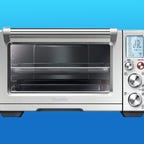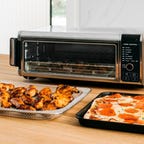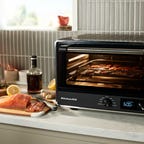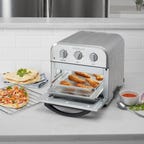Best Air Fryer Toaster Ovens for 2024
Having an air fryer that doubles up as a toaster oven saves space. We tested and picked the best air fryer toaster oven options on the market.
What to consider
Cooking modes and special features
Size and capacity
Cost and value
Our Picks

Air fryers are typically crock-pot-like accessories, but that's not the only form they arrive in. If you like kitchen appliances that do more than just one thing, getting a toaster oven that is also an air fryer might be a good decision. We've picked out the best air fryer toaster oven models, which are a little more like toasters but come with the added functionality of an air fryer.
What's the best overall air-frying toaster oven?
I've tested dozens of toasters and air fryers and now hybrid models that do it all. After hours of browning, broiling, baking, toasting and air-frying with hot air, Ninja's Foodi toaster with its powerful air fryer function lands atop this list as the best toaster oven and air fryer for 2024.
Pod-shaped air fryer ovens mostly do one thing: air fry. You can control the temp, but you're limited to a single cooking function -- there's no broiling, for instance -- and it's much harder to be precise if you're making something finicky and not simply crisping up fried food, frozen pizza or frozen french fries. They also have smaller capacities in comparison to their overall size so I wouldn't call them good space-budgeters, especially if you want one that'll cook enough for two or more people. If you're a little tight on kitchen space, like this New Yorker here, an air fryer/oven combo will do the work of an air fryer and a toaster and some models, like the flip-up Ninja Foodi Air Fryer Oven, don't take up much counter space at all.
Here's how the hybrid ovens performed and a few of my top picks.
Best air-frying toaster ovens of 2024
The small yet mighty Ninja Foodi bested all others in my final assessment and placed either first or second in nearly every single test I ran, blending fierce power, consistency and control. The Ninja preheated the fastest (by far) and kept its heat consistent throughout. The air fryer function was also best in show and it broiled a salmon filet nicely. It's also the most compact of these countertop ovens and the only model that flips up via a hinge in the back to rest no more than 7 inches from the wall.
One drawback is the Ninja's interior size, but I suspect that's also why it works as well as it does. The Ninja is short -- about 6 inches and half the height of many of the others -- so you're somewhat limited in what you can put inside. It also makes things a bit clumsy when you're loading food in and taking it out and it's harder to see while it's cooking.
Best-looking air fryer and toaster
KitchenAid Digital Countertop Oven
While the KitchenAid didn't run away with many of the test categories, it didn't struggle mightily in any of them either. It sports a serviceable air fry function -- although certainly not the best -- excellent temperature consistency and a very sleek and intuitive control panel (my favorite of the lot). It makes the list because I found it to be a reliable oven that's also an ideal size for most kitchens and its sleek and modern design was my favorite of the bunch.
It's a bit of a hybrid between the Ninja and the Breville in that it's compact -- just 17 inches across versus the Breville at more than 21 -- but also has a more traditional cooking capacity so you could get some taller items in there, whereas the Ninja is limited in that department. It also looks great, which always counts for something.
Best air fryer and toaster to replace your big oven
Breville Smart Oven Air Fryer Pro
While the Ninja Foodi took the top spot in a majority of tests, the Breville nabbed a few wins, too, including a win for best-broiled salmon and a dead tie in the cookie competition. It is the one model on this list that could come close to replacing your big oven altogether. It also keeps an accurate and consistent heat throughout cooking and has an impressive air fryer function.
This Smart Oven is large, for better or worse, but that bulbous cooking capacity makes it a more versatile machine than the Ninja. It also has a boatload of features and presets -- bread proofing, dehydrating, pizza -- and if you like bells and whistles, the Breville's got them all. At $400, it's by far the most expensive oven I tested, but the quality build and performance were commensurate.
Best budget air-frying toaster
Cuisinart Compact Airfryer Toaster
This powerful toaster oven and air fryer can often be found on sale for around $100, making it the best-value oven on our list. Cuisinart toasters often pack a mighty punch, so be aware when cooking or you might end up with burnt french fries or overcooked chicken.
This model has basic manual dials including one to control the function -- bake, broil, air fry, warm and pizza - one to control the temp and another which functions as a timer. This oven is also on the smaller side, which may be ideal for a kitchen without a ton of counter space, but less so if you're regularly cooking for a large group.
Air fryer toaster ovens compared
| Breville BOV900BSSUSC | Calphalon TSCLTRDG3-AF | Cuisinart TOA-65 | Crux 14805 | KitchenAid KCO124BM | Ninja SP101 | |
|---|---|---|---|---|---|---|
| Energy Draw | 1,800 watts | 1,400 watts | 1,800 watts | 1,800 watts | 1,800 watts | 1800 watts |
| Settings | Toast, bagel, broil, bake, roast, warm, pizza, proof, air fry, reheat, cookies, slow cook and dehydrate | Air fry, bake, toast, roast, broil, bagel, pizza and defrost | Bake, broil, pizza, roast, toast, bagel, reheat, warm and dual cook | Bake, broil, roast, bagel, warm toast, pizza, reheat and dehydrate | Bake, roast, air fry, toast, broil, warm, and crisp and dehydrate, proof, bagel, warm and reheat | Air fry, air roast, air broil, bake, bagel, toast, dehydrate and keep warm |
| Max temperature | 480 °F | 450°F | 450°F | 450°F | 450°F | 450°F |
| Preheat time to 350 °F (minutes) | 5:00 | 3:45 | 3:30 | 3:00 | 3:00 | 0:50 |
| Exterior dimensions L x W x H (inches) | 21.5 x 17.5 x 12.7 | 11.6 x 18.7 x 15.8 | 17 x 21.73 x 15.75 | 17 x 13.85 x 9.29 | 17 x 16 x 11.3 | 19.7 x 7.6 x 15 |
| Temperature accuracy (350 °F for 10 minutes) | -5 | -13 | -4 | 10 | 0 | -7 |
| Weight (pounds) | 39 | 22 | 28.5 | 16 | 21 | 18.5 |
| Color | Silver or black | Black | Silver | Silver | Black | Silver and black |
| Key features | Large capacity | None | Powerful air fryer | None | Sleek design and interface | Extremely compact |
| Warranty | 2-year | 1-year | 1-year | 1-year | ||
| Price | $400 | $175 | $120 | $180 | $220 | $150 |
Other air fryer toaster ovens we tested
The Cuisinart Digital Air Fryer Toaster Oven: This hybrid convection oven and air fryer wasn't terrible and it certainly had one of, if not the most powerful, air fry functions. That proved to be a blessing and curse since some of the food I cooked burned on the edges and cooked unevenly.
Calphalon Precision Air Fry Oven: The Calphalon scored high marks in the toast test with even browning, but that's about where the accolades ended. This oven was slow to preheat, had trouble holding a consistent temperature and the air fry function was among the weakest.
Crux 10-in-1 Toaster with Air Fry: The Crux oven is nice to look at and comes in either both a black or white finish with red trim. While the air fryer function was great, this oven struggled when asked to do gentler, more precise cooking jobs such as evenly toasting a slice of bread.
Who's hungry?
What to consider when buying an air-frying toaster oven
Cooking modes and special features
Since you're potentially going all-in on one machine, there are a few functions you want it to perform and perform well. For the purposes of this list, I took four main cooking functions into account: Air fry, broil, bake and toast. These, along with roast, are the oven duties the average home cook will rely on most. While some of these cookers sport dehydrate, proof, pizza and other niche cooking functions, most didn't, so I stuck to testing functions that were possible across all the hybrid ovens.
Cuisinart makes an affordable countertop oven with one of the fiercest air fryer functions of any I tested.
Air frying: This trendy term has nothing to do with frying but rather mimics the results of deep-frying using super hot, fast-moving convection air for food that's crispy outside and moist inside. Having an air fry function was the baseline criterion for consideration on this list. You can air fry lots of things, but chicken wings and french fries are two popular options, so I employed them for testing.
Broiling: I'm a big broiler person, especially for fish but also for things like mac and cheese, certain chicken recipes and anything else I want a crispy crust on top of. I find that ovens differ wildly in broiling ability so I wanted to see which of these ovens did it best.
Baking: Baking can mean a lot of things but when it comes to, let's say cookies and cupcakes, consistency is key. The sign of an oven that bakes well is simple: Will it hit the temperature you set it to and then stay there consistently throughout the bake?
Toasting: Like many people, I do a fair amount of toasting -- bagels, bread and the occasional Eggo -- and so I wanted to see how well, evenly and accurately (according to the oven presets) these machines could toast.
"What about roasting?" Not a bad question, but roasting is essentially baking at a higher temperature and is also a term generally just used to designate cooking foods with structure, including meat and vegetables. The tests I ran for baking -- temperature consistency and accuracy -- can be loosely applied to roasting so if an oven gets hot and stays hot, we can assume it's going to roast well, too.
Size and capacity
Try to picture what you'll be cooking in your air fryer oven and that will help you determine which size to buy. Models such as the Breville are large enough to fit a whole chicken while smaller models like the KitchenAid are better suited for cooking for two to three people at a time.
There is also the issue of how much space the oven takes up in your kitchen. Remember, these will likely live permanently on the counter. The Ninja Foodi oven is the most efficient oven on our list in terms of counter space since it flips up on a hinge and sits flat against the wall when not in use.
Cost and value
Spending more on an air-frying toaster will likely get you more special features and a sleeker interface but not necessarily better results. While premium models such as the $380 Breville Smart Oven Air are a joy to use, the Ninja and Cuisinart delivered equally delicious wings, fries and toast for about half the price.
How we tested air fryer toaster ovens
Air-fryer chicken wings
Ninja's air-fried wings were a thing of beauty.
Chicken wings are almost universally loved and a very popular item to air fry. The goal for an air-fried wing is crispy outside and skin with a juicy inside. To test each oven's air fry ability, I cooked three frozen wings on air fry mode at 450 degrees F for 30 minutes, turning them every 10 minutes. I let each oven come to full preheat before putting the wings in and then photographed them immediately after pulling them out. Naturally, I tasted them too, when they were cool enough to eat.
Success here depends on high heat and good fan circulation of that hot air, which, in turn, means faster cooking. The faster an air fryer cooks and the more effective the super convection is, the faster the outside skin will crisp, making it less likely the chicken will be dry inside.
The Ninja Foodi oven won the great wing war by a feather, with the crispiest wings after 30 minutes. They were also perfectly juicy inside and had no real visible burning. The Cuisinart also nailed the wing test, but I actually had to pull them after about 25 minutes because they were fully done. They even had some burnt skin but not enough to bother me. The Breville and Crux also did well with good browning and crispy skin, while the KitchenAid finished sixth and the Calphalon seventh with not enough browning or crispiness for my taste.
Air-fryer french fries
Air fryer french fries are very popular in my home. All the ovens did pretty well in this test, but the Ninja and Breville cooked them to a golden brown the fastest without burning.
This second air fryer test was designed to illuminate the pure power and speed of an individual oven's air fry function, but also its ability to cook evenly. I placed a handful of frozen french fries (McDonald's style) on air fry at 450 F and timed how quickly each one got to that golden brown color that we all covet. Because speedy cooking and convenience are key features of the countertop air fryer oven, faster equals better. All of the oven subjects (except for the Cuisinart) reached the desired doneness eventually, but some performed the task much more quickly and consistently than others.
Breville won the fry test with perfectly golden fries in six minutes. I set the Ninja to a slightly lower temp (390 F) per its manual, and in eight minutes I had perfect fries (a very close second place and it likely would have won or tied if I'd set it to 450 F). KitchenAid also took eight minutes on 450 F while the Crux took nine minutes to get there and the Calphalon took 12. The Cuisinart was actually the fastest at just three minutes, but it burnt the edges of the fries and didn't cook evenly. At this point, I began to suspect the Cuisinart has an unusually intense air fryer function, for better or worse.
Broiled salmon
In real life, I probably would have given this another minute under the broiler, but the Breville (pictured here) and Ninja were the only ovens that imparted any sort of crust after four minutes.
To test the broiler, I brushed a 4-ounce salmon filet with a mixture of mustard, olive oil and brown sugar. After the oven came to preheat, I snuck the salmon under the broiler about 2 inches from the top and left it there for four minutes before removing it from the oven for a photoshoot.
The key thing I looked for here was how well each broiler imported a caramelized crust on the top of the fish. Some ovens, like the Calphalon and Cuisinart, showed almost no signs of browning, while the Ninja and Breville delivered nice color and the beginnings of a good crust. I decided they would share the blue ribbon for this test. The KitchenAid and Crux both showed some browning, landing them in third and fourth place.
Plain old toast
Both the Calphalon and Ninja made very pretty toast that matched their medium presets, but the Ninja (pictured) did it in half the time.
This test was to see how accurate a particular oven's toaster presets are and how fast it can toast. I stuck one slice of bread in each toaster and set it to medium. I didn't weigh this test as heavily as the others because, in truth, any of these ovens will get you to the desired toastiness, it just may take more (or less) time, some tinkering or learning of the presets to get it how you want it.
How long each cook time was for the "medium" preset on each oven varied rather significantly, ranging from over six minutes for the Calphalon to just three and a half for the Ninja. As it was, these two produced the most even and attractive toast that corresponded to the preset, but the Ninja (winner!) did it in half the time. The Breville, KitchenAid and Crux barely toasted the bread at all when set to medium -- which simply means you'd have to use a darker setting -- while the Cuisinart over-toasted the bread.
Baked cookies
It's a two-way tie -- Breville and Ninja -- in the cookie contest. Both ovens hit the set temp and held it consistently throughout the 10 minutes.
Next, I wanted to see how accurately and consistently each oven could reach and hold a temperature, and baking a cookie is a perfect test for that. I plopped a spherical tablespoon worth of Toll House cookie dough on parchment paper and stuck one in each oven on the middle rack for the recommended time and temp (350 degrees F for 10 minutes).
The cookie race was a photo finish between Ninja and Breville, both of which delivered near-perfect results. The Cuisinart cookie was overbaked, as was the Crux (although just slightly), while the KitchenAid cookie was a tad underbaked.
Preheat test
Another big draw for using a countertop oven over the big oven is the speed at which it preheats. During the cookie bake-off, I timed each oven to see how fast it came up to 350 degrees F.
The Ninja Foodi blew all the others away, preheating to 350 at a lightning-fast 50 seconds. Most of the others clocked in around three and a half minutes, while the larger Breville took five minutes to come to temp. While I didn't do an official test for air fryer preheat, I did notice the Calphalon took markedly longer than the others to get to 450 degrees F on air fry.
Temperature accuracy and consistency test
This is low-key one of the most important functions for any oven, especially if you plan to do some light baking in it. If an oven can't hold an accurate and consistent temperature, it makes following recipes far more difficult, and you'll be forever adjusting and hawking your food to make sure it doesn't burn. I used thermocouples to read the internal temperature of the oven while it baked for 10 minutes at 350 degrees F. I was able to get an average temperature reading for the duration of the bake, but I also watched the thermometer in real-time to see how much fluctuation happened during the cook.
The KitchenAid won this test with an average reading of 350 F on the nose and with very little fluctuation. The Ninja (343 F average temp), Cuisinart (346 F) and Breville (345 F) also did well, although the Breville started off very hot and then came back down. The two last-place finishers were the Crux, which ran hot (365 F) and the Calpahlon, which ran cold (337 F). Both were also the most inconsistent throughout the bakes.
Cleaning and care
A smart design feature allows you to get right inside the Ninja oven and give it a good cleaning, something you'll likely need to do regularly because of its compact hull.
With the exception of the Ninja (more on this in a second), there is nothing particularly unusual about caring for or cleaning these ovens. They have standard box interiors of various sizes made from stainless steel that will require regular scrubs and wipes. Each oven also has a removable, dishwasher-safe crumb tray to catch fallen fries and toasty bits.
Now back to the Ninja. Because of the compact interior, this oven is definitely more prone to splatter and stains, especially when making foods with fat and grease such as wings. Thankfully, there is a smart design feature that allows the entire bottom floor of the Ninja oven to fold out so you can get right inside with a rag or Brillo pad and wipe it down. I am sure the Ninja will require more frequent cleaning than the others. If that's not something you're diligent about, it's certainly something to consider.




